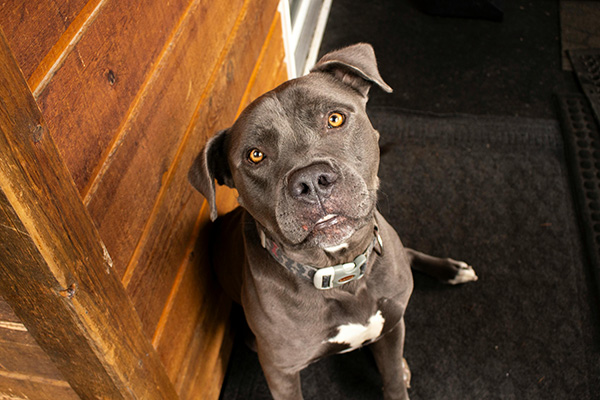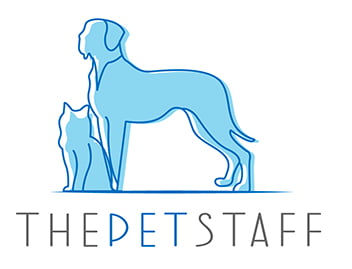Just like humans, dogs can experience anxiety. While occasional anxiety in dogs is a normal response to certain situations, chronic anxiety can negatively impact a dog's well-being and behavior. Recognizing the signs of anxiety, such as changes in body language like forward-facing ears or when a dog shows signs of stress, is crucial. Treatment options like behavior modification, using natural products, and consulting a veterinarian to rule out conditions like cognitive dysfunction syndrome can help most dogs. Understanding these factors helps your pet live a calmer, happier life.
What is Dog Anxiety?
Dog anxiety is a reaction to stress or unfamiliar situations. It can present in different ways, ranging from slight discomfort to significant behavioral shifts. If left unchecked, anxiety can lead to destructive behaviors, health issues, and a diminished quality of life for your dog.
Types of Dog Anxiety

Separation Anxiety
Separation anxiety is a prevalent type of anxiety seen in dogs. Indicators of this condition include excessive barking, destructive actions, and inappropriate elimination when they are left alone. Behavior modification and positive reinforcement can help an anxious dog cope.
Noise Anxiety
Loud sounds such as thunderstorms, fireworks, or construction work can provoke anxiety in dogs. During these events, many dogs may hide, shake, or show excessive vocalization. Monitoring body language like dilated pupils can help recognize stress.
Travel Anxiety
Traveling by car or plane can be stressful for dogs. Anxiety issues during travel may cause dog symptoms such as restlessness or vomiting. Offering a stress reliever or consulting a veterinarian for advice can help a dog cope with travel anxiety.
Social Anxiety
Some anxious dogs that aren’t used to interacting with other dogs or people may develop social anxiety, showing fear or aggressive behavioral issues in unfamiliar settings. Slow exposure combined with positive reinforcement can assist them in adapting.
Generalized Anxiety Disorder
In some cases, dogs experience chronic dog anxiety without a clear trigger. This form of anxiety in dogs is harder to manage but is important to address early. Speaking with a veterinarian can help eliminate any underlying medical issues and create an appropriate treatment plan.
Causes of Dog Anxiety
Genetic Predisposition
Some dog breeds are genetically predisposed to experience anxiety more than others. Breeds like Border Collies, German Shepherds, and Labrador Retrievers are often more susceptible to developing anxiety in dogs, especially when faced with stressful situations like unfamiliar environments. These breeds may show more anxious behaviors than others, making them more likely to exhibit symptoms such as excessive barking or destructive behaviors.
Fear-Related Anxiety
Loud noises, such as fireworks, or stressful events like visits to the vet can often trigger anxiety in dogs. This type of anxious dog response is known as fear-related anxiety, where the dog may exhibit signs such as dilated pupils, shaking, or even aggression. In such cases, dog owners should consult a veterinary behaviorist to understand their dog’s triggers better and help manage anxiety disorder through techniques like behavior modification.
Separation Anxiety
Separation anxiety is a leading cause of anxiety in dogs. It happens when dogs become excessively bonded to their owners, resulting in significant distress when they are left alone. Signs of anxiety in these dogs can include barking excessively, licking excessively, or displaying destructive behaviors such as chewing furniture. If left untreated, this condition can escalate, and many anxious dogs may require prescription medications or anti-anxiety medications to help manage their symptoms.
Aging and Cognitive Dysfunction
As dogs get older, they can develop cognitive dysfunction syndrome, which is akin to Alzheimer’s disease in humans. This condition leads to confusion and anxious behavior, especially in senior dogs. Signs of anxiety in older dogs often manifest as restlessness, compulsive behaviors, or even aggression. Pet owners need to work with a veterinarian to determine whether underlying medical conditions or cognitive dysfunction are contributing to the dog’s anxiety symptoms and to develop strategies for managing anxiety in senior dogs.
Past Trauma
Dogs that have experienced trauma, including neglect, abuse, or abandonment, are at a higher risk of developing chronic anxiety disorders. Rescue dogs, in particular, are prone to anxiety as a result of their previous environments. This form of dog anxiety can be challenging to address, but with positive reinforcement training and creating a safe space, many of these stressed dogs can improve over time.
Lack of Socialization
Puppies that aren’t properly socialized may develop behavioral issues as they grow up, often becoming fearful of strange people, new places, or other dogs. Insufficient early socialization is a frequent contributor to anxiety in dogs, resulting in stressful situations during daily activities. Behavior modification and exposure to positive experiences like dog parks or taking a long walk can help these dogs develop normal behavior and reduce stress.
In each case of anxiety in dogs, working with professionals in veterinary medicine, such as a veterinarian or veterinary behaviorist, can be key in addressing behavior problems and finding appropriate treatment options, such as natural products, stress relievers, or anti-anxiety medications. Dog owners can also create a quiet space for their anxious dog at home, helping their pet feel safe during anxious situations.
Symptoms of Dog Anxiety

Excessive Barking and Whining
If your dog barks excessively or whines, it could be a sign of stress or uncertainty. Monitoring body language, such as forward-facing ears or excessive vocalization, can help identify anxious behaviors.
Pacing and Restlessness
Constant pacing and restlessness can be an indication that your anxious dog is struggling to cope. This behavior often occurs when the dog is feeling stressed or anxious due to separation anxiety, fear, or anxiety disorder. Dog owners might notice that their dog physically cannot relax, which can worsen over time if left untreated. Providing a quiet space and ensuring regular exercise like a long walk can help the dog relax.
Destructive Behavior
Dogs experiencing anxiety issues frequently exhibit destructive behaviors, like chewing on furniture or scratching doors. Such actions are commonly observed in dogs with separation anxiety or those that are left alone for long durations. Pet owners should observe their dogs' responses and seek ways to help them cope, such as creating a safe space or using positive reinforcement to encourage normal behavior. In some cases, prescription medications or natural products can help reduce behavior problems associated with anxiety.
Shaking and Trembling
When a dog is excessively panting or drooling, despite no change in temperature, it could be due to anxiety in dogs. This is especially common in stressful situations, where anxious dogs might exhibit physical signs of stress. Pet owners should be aware of these dog’s symptoms and observe whether the behavior correlates with any particular dog’s triggers or stressful situations. Working with a veterinarian can help determine whether underlying medical conditions are contributing to the dog's anxiety.
Aggression
In some cases, anxiety in dogs can lead to aggression. When anxious dogs feel cornered or threatened, they may become aggressive toward other dogs, people, or even objects. This type of behavior is often seen in dogs with anxiety disorders, especially when they feel trapped in stressful environments. Dog owners should be aware that not all dogs react aggressively, but for those that do, it is crucial to address this through proper training and potentially consulting a veterinary behaviorist for guidance on behavior modification.
Urinating or Defecating Indoors
Accidents inside the house, especially for a house-trained dog, may indicate anxiety, particularly when left alone. The dog's response can be a sign that it feels insecure or fears being separated.
Diagnosing Dog Anxiety
After assessing your dog’s behavior and pinpointing potential triggers, it’s important to seek advice from a veterinarian or a certified animal behaviorist for an accurate diagnosis. These experts can help confirm whether the behavior is due to anxiety and suggest an appropriate treatment plan. They may recommend medications if the anxiety is severe or suggest behavioral modifications that can help reduce stress and anxiety in your dog. Collaborating with a professional guarantees that the anxiety is accurately identified and effectively addressed.
At times, a behavior assessment can be conducted to gain deeper insights into your dog’s anxiety. These assessments involve exposing your dog to various stimuli or situations to observe their reactions and measure their anxiety levels. For instance, the veterinarian or behaviorist might test how your dog responds when separated from you or introduced to new environments. The findings from these assessments offer a better understanding of the anxiety's severity and assist in creating an appropriate treatment plan.
Treatment Options
Training and Socialization
Early socialization helps prevent dog anxiety by exposing dogs to other dogs, new environments, and strange people. Positive reinforcement and behavior modification can help anxious dogs adjust to stressful situations, such as loud noises. Not all dogs will develop anxiety, but early training reduces the risk.
Creating a Safe Space
A designated safe space like a quiet room or crate helps stressed dogs feel secure during anxious situations. Observing your dog’s body language—such as dilated pupils or forward-facing ears—can help you identify when they need this space to avoid anxiety triggers.
Medication
In severe cases of dog anxiety, prescription medications like SSRIs or Trazodone may be needed. Always seek advice from a veterinarian to eliminate any underlying medical issues and confirm that the treatment effectively addresses your dog's anxiety symptoms.
Natural Remedies
Natural products like CBD oils, pheromone diffusers, and calming supplements can help with mild anxiety in dogs. These options provide a gentler approach for most dogs and can reduce anxiety symptoms without significant side effects.
Exercise and Mental Stimulation
Daily exercise and mental activities, such as dog parks or interactive toys, help prevent anxious behaviors. Engaging your dog physically and mentally is key to reducing stress and helping them cope with boredom or anxiety.
Products and Tools for Anxiety Management

Anxiety Vests
Anxiety vests, like ThunderShirts, apply gentle pressure to help an anxious dog calm down during stressful situations, such as loud noises like fireworks. These vests can reduce a dog's anxiety by helping them cope with stress.
Interactive Toys
Toys like KONGs provide mental stimulation and stress relief for anxious dogs. They help manage compulsive behaviors and anxiety by keeping dogs focused on healthy distractions.
Calming Music and Sound Therapy
Music for dogs or white noise machines can drown out anxiety-inducing sounds like thunderstorms, which often trigger excessive vocalization or barking excessively in stressed dogs.
Preventing Dog Anxiety
Routine and Consistency
Dogs flourish with routine. Maintaining a regular schedule for meals, walks, and playtime can help reduce anxiety in dogs. Most dogs feel more secure with a predictable routine, reducing the chance of anxiety issues.
Early Socialization and Outdoor Time
Socializing puppies from a young age can help prevent future dog anxiety by exposing them to other dogs, people, and different environments in a positive way. This reduces the risk of developing behavioral issues like excessive vocalization or fear of strange people and sounds like loud noises.
Regular physical exercise is essential for alleviating anxiety in dogs. Regular walks, trips to dog parks, and playtime help anxious dogs burn off excess energy, keeping them mentally and physically balanced and reducing dog's anxiety and compulsive behaviors.
Use Positive Reinforcement Training
Using positive reinforcement training techniques helps build your dog’s confidence and prevents anxiety. Reinforcing positive behavior with treats, praise, or playtime helps your dog link new experiences and commands to favorable outcomes. It's important to steer clear of punishment-based training, as it may heighten fear and anxiety. Teaching basic commands like "sit," "stay," or "come" can give your dog a sense of control and security, reducing stress in unfamiliar or anxiety-inducing situations.
Gradual Exposure to New Experiences
Gradually exposing your dog to new experiences, people, and environments can help prevent fear and anxiety in the future. Proper socialization, especially when they are puppies, can prevent anxiety in unfamiliar situations. Gently introducing your dog to new sounds, people, pets, and environments in a positive, controlled manner fosters confidence and minimizes the chances of developing fear-based anxiety. Always accompany these new experiences with positive reinforcement, such as treats and praise, to help them feel safe.
Provide Regular Exercise and Mental Stimulation
A key method for preventing anxiety in dogs is to provide ample physical and mental stimulation. Engaging in regular exercise, like daily walks, playtime, or runs, helps expend excess energy and alleviate stress. Equally vital is mental stimulation, which can involve interactive toys, puzzle feeders, or training activities. A tired, engaged dog is less likely to feel anxious or restless. Engaging your dog in activities like fetch, obedience training, or agility courses can help them feel more secure and calm.
Create a Safe, Comfortable Environment
Dogs need a designated space to feel safe and secure, especially when left alone. Create a comfortable space, such as a crate or a quiet room with their bed, toys, and blankets, where your dog can retreat when they feel stressed or anxious. When properly introduced, a crate can serve as a safe den for your dog, giving them a sense of security. Ensure the environment is calm, free from loud noises, and provides familiar scents to help your dog relax.
